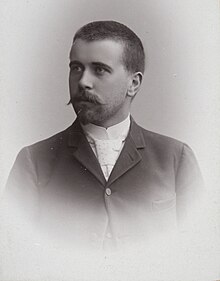Ernst Leonard Lindelof
Ernst Leonard Lindelöf (born March 7, 1870 in Helsingfors ( Helsinki ), Grand Duchy of Finland , † June 4, 1946 in Helsinki) was a Finnish mathematician .
Life
Ernst Lindelöf was the son of Lorenz Leonhard Lindelöf (1827–1908), who, after completing his doctorate in Helsinki (Helsingfors), was a mathematics professor there from 1857 to 1874 and then in the Ministry of Education. Ernst Lindelöf also studied mathematics in Helsingfors from 1887 with stays abroad in Stockholm in 1891 and in Paris in 1893/94. In 1893 he received his doctorate from Hjalmar Mellin in Helsingfors ( Sur les systèmes complets et le calcul des invariants différentiels des groupes continus finis , Acta Soc. Scient. Fennicae, Volume 20, 1893) and after graduating he was a lecturer in Helsingfors. In 1901 he attended the University of Göttingen . In 1902 he became associate professor and in 1903 professor in Helsingfors. In 1938 he retired.
From 1907 he was one of the editors of Acta Mathematica, and he was a member of the Finnish Academy of Sciences and, since 1931, a corresponding member of the Prussian Academy of Sciences . In 1921 he was elected a corresponding member of the Göttingen Academy of Sciences .
plant
Ernst Lindelöf had a central position in Finnish mathematics at the beginning of the 20th century, which produced many outstanding function theorists, and had a role in school. His doctoral students include Lars Ahlfors , Pekka Myrberg and Rolf Nevanlinna . He made important contributions to analysis , particularly to function theory and the theory of differential equations .
The Lindelöf space in topology is named after Ernst Lindelöf , a topological space in which every cover by open sets contains a countable subset that is still a cover.
Several mathematical theorems are named after Lindelöf, including the Picard-Lindelöf theorem on the existence and uniqueness of the solutions of ordinary differential equations, the Phragmén -Lindelöf theorem on the growth of holomorphic functions in certain areas ( e.g. sectors or stripes) and the Lindelöf theorem on asymptotic values of bounded (or normal) holomorphic functions in the unit disk. In analytic number theory there is the Lindelöf conjecture about the increase in the Riemann zeta function on the critical straight line.
Lindelöf also dealt with the history of Finnish mathematics and he is also known for his textbooks: reading his Introduction to Analysis made Rolf Nevanlinna , for example , turn to mathematics.
Family and private
Rolf Nevanlinna was Lindelöf's great cousin. Ernst Lindelöf's father, Lorenz Lindelöf, was married to Gabrielle Krogius, a sister of the grandmother (paternal side) Elise von Rolf Nevanlinna - she was married to Nevanlinna's grandfather Edvard Neovius. The predecessor of Ernst Lindelöf as a mathematics professor in Helsinki, Ernst Neovius, also comes from the Neovius family (Nevanlinna is the finished form of the name). Lindelöf's brother is the philosopher Uno Lorenz Lindelöf .
Lindelöf was an excellent violinist and played in a quartet with Jean Sibelius in his youth .
Others
The asteroid (1407) Lindelöf is named after him.
Fonts
- Le calcul des résidus et ses applications à la théorie des fonctions. Paris, Gauthier-Villars, 1905, Reprint Chelsea, New York 1947, online and in Project Gutenberg
- Introduction to Higher Analysis. Teubner 1934, 2nd edition 1950 (after the Swedish edition 1912 translated into German by Egon Ullrich )
Web links
- Literature by and about Ernst Leonard Lindelöf in the catalog of the German National Library
- John J. O'Connor, Edmund F. Robertson : Ernst Leonard Lindelöf. In: MacTutor History of Mathematics archive .
- Ernst Leonard Lindelöf at the Mathematics Genealogy Project
Individual evidence
- ^ Mathematics Genealogy Project
- ↑ Holger Krahnke: The members of the Academy of Sciences in Göttingen 1751-2001 (= Treatises of the Academy of Sciences in Göttingen, Philological-Historical Class. Volume 3, Vol. 246 = Treatises of the Academy of Sciences in Göttingen, Mathematical-Physical Class. Episode 3, vol. 50). Vandenhoeck & Ruprecht, Göttingen 2001, ISBN 3-525-82516-1 , p. 152.
- ^ Lindelöf around 1890, published in Compte Rendu of the Paris Academy, Volume 118, 1894 ( Sur l'application de la méthode des approximations successives aux equations différentielles ordinaires du premier ordre ). Independent of Émile Picard around the same time. Compare Harro Heuser Ordinary Differential Equations , 3rd Edition, Teubner 1995, p. 149.
- ↑ Lindelöf, Lars Phragmén Sur l'extension d'un principe classique de l'Analyse et sur quelques propriétés de fonctions monogènes dans le voisinage d'un point singulier , Acta mathematica, Volume 31, 1908, pp. 381-406
- ↑ Olli Lehto Sublime Worlds , Birkhäuser, p. 36. The same was also the case with Lehto, as he mentions in his biography of Nevanlinna.
- ↑ Olli Lehto Sublime Worlds , Birkhäuser Verlag, p. 37
- ↑ Lehto Sublime Worlds , p. 38
| personal data | |
|---|---|
| SURNAME | Lindelöf, Ernst Leonard |
| BRIEF DESCRIPTION | Finnish mathematician |
| DATE OF BIRTH | March 7, 1870 |
| PLACE OF BIRTH | Helsingfors ( Helsinki ), Finland |
| DATE OF DEATH | June 4, 1946 |
| Place of death | Helsinki , Finland |
